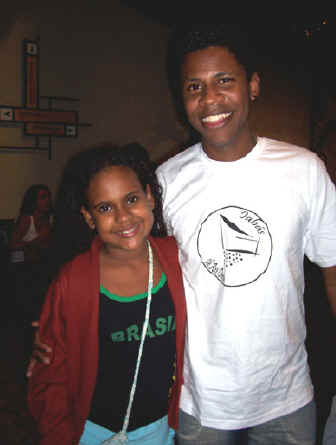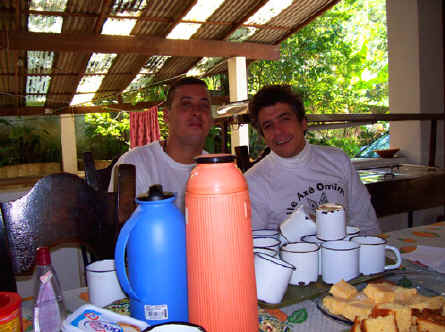Terreiro structure and functions
I think that the most profound thing I realized when I experienced daily life in the terreiro was that the terreiros themselves are what creates the largest difference between the way African diasporic beliefs are practiced in a Cuban and North American context and the way they function in Brazil and Haiti.
The ability to own a sacred space and have established temple compounds insures both stability and continuity in religious worship and allows for the development of permanent communities of worship.
The religious practice of Lukumi (Santeria) of Cuba, Puerto Rico and the United States, (and more recent African-traditional worship) has historically been persecuted - and adherents have never had the ability until very recently to practice openly without the fear of being arrested. Though candomblé followers were and are also subject to persecution - their sheer numbers and ownership of temples creates a different social condition.
Lukumi - born in Cuba of Yoruba roots developed under a slave system which precluded long lived quilombos (escaped slave settlements) due to the size of the island - and after emancipation since few blacks could own land, the dominance of large plantation owners continued up until the Cuban revolution of 1959.
Those Cubans who fled the revolution in the early 60's and arrived in New York, Puerto Rico and Miami , bringing their religious system with them, had to practice in secret. Though they later (60's) began to initiate Puerto Ricans, African-Americans and Euro-Americans, all rituals were hidden from the general public and police agencies, and an atmosphere of fear prevailed.
The Lukumi religion in Cuba though as old as Candomble (both were established during the latter part of the slave trade) also differed in sheer numbers, and there were variances between the colonial policies of Spain and Portugal.
These variables contributed to a sharp divergence in practice, and structure.
Though I found many similarities - and acceptance as a priest of a branch tradition from the same African root, as an anthropologist I had to begin to try to understand the reasons behind these divergences.
The following are some of the positions and functions (division of labor) in a candomblé ile:
Pai
or Mae de Santo,
Babalorisha/ Iyalorisha – head of the Ile – the initiator and diviners,
only they have the right to divine with shells.
They also own the terreiro (the land and property, the Ile)
Babalorisha Jose Flavio and one of the young Ile members
Denise, Pai Jose Flavio, and Mae Maria
Egbomis – elders – (this includes all Ogans, Ekedis) but is usually used to indicate a person who has the capacity to go into trance and be mounted by Orisha, who has completed the seven year obligation.
Aduni, an Abiyan (non-initiated member of the ile)
Ekedis – women who take care of the persons mounted by Orisha, who dress the Orishas, give herbal baths, and they are the administrators of the daily functions of the Ile, care for Iyawos in the terreiro.
Ogans – drummers, matanceros, political clout, protectors
titles of Ogans: Alabe, Asogun (matancero), Pejigan.
The Alabe is a title given to the chief drummer.
Ekedis and Ogans are automatically considered to be elders directly after initiation and are called "Mae" and "Pai" by everyone.

Young Ekedi and Ogan Alabe Modupue
Modupue repairing one of the consecrated drums

Elegun – subidor – person who gets mounted . Until that person has completed a 7 year ritual obligation they are not considered to be an adult.
Rosa - Priestess of Iyemanja (Yemaya ) - an adult elder
A person who can go into trance is also referred to as a Iyawo - bride of the Orisha.
Donna - A Iyawo of Ochunmare - under 7 years
Iyawo is a term with a variety of meanings – but is only applied to those who mount (bride of the Orisha). The Lukumi one year only period of Iyaworage does not exist.
One
becomes a functioning priest after completing several preliminary
“obligations” – at 3 months, at one year, at three years and most
importantly after 7 years (after which one is considered to be a priest.
Maria, and I were seated in chairs, as were several other visiting elders from other iles.
Me with Leo - a
visiting elder Babalorisha Ochun, the night of the shire.
Next - Other spaces in the terreiro